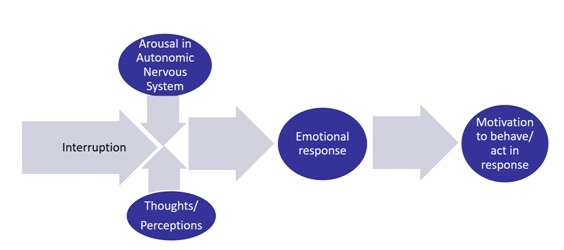Facial and body language analysis are hot right now. Major companies are offering software that can record and analyze emotional expressions. And they can do it real time. Market researchers now have an incredible amount of data at their fingertips about how people react to stimuli such as advertisements and product ideas.
Many providers of these services are suggesting that emotional expressions and other body language are giving the real picture of what people are actually feeling and that we can uncover more insights when we delve into this reality. But is that true? Are we actually just adding a lot more data to analyze, or are we truly finding something new and different in our research? Using current theories and research on emotions from the field of psychology can help us to make sense of all this information.
When and Why Emotion Is Important for Consumers
Let’s begin with the current psychological research on emotions. Researchers contend that emotions are primarily motivational and serve humans and animals in adapting to situations and thriving. The experience of emotion involves some level of arousal in the autonomic nervous system that is caused by an interruption of some type that draws the person’s attention to the situation.
The perception and evaluation of this situation leads the individual to an emotional reaction that is usually adaptive. For example, when a large predator appears, one experiences fear. If someone is being aggressive, one might experience anger in response. As a result, emotions often have a clear behavioral component (e.g., fear = retreat, anger = fight, sadness = disengagement, happiness = engagement, etc.) As a result, many researchers believe that emotions are a key part of human evolution and are essential to human survival. Below is a representation of how this process works.

Given the importance of emotions, it’s not surprising that they have a large influence on purchasing behavior. Individuals remember more emotional events than non-emotional ones (Buchanan & Adolphs, 2002; Hamann, 2001) and will recall more details about such emotional events (Kesinger & Schacter, 2008). Thus, brands with strong emotional associations should be more likely to be remembered and considered.
Research has also shown that emotions at the time of purchase influence buying behavior (Rick & Loewenstein, 2008). Happy people buy more than sad people, who often spend more time deliberating over these decisions. And interestingly, expected emotions also influence purchase decisions (Rick & Loewenstein, 2008). The expectation of how a product will make a person feel is often a part of the purchase process as consumers imagine how life will be and how they will feel after buying something.
Applications to Market Research
Market researchers are smart to try to understand what role emotions play in consumer behavior. But does coding facial expressions in response to advertisements, discussions, or text tell us that a product is more likely to be purchased or that a brand is more likely to be considered? There are several issues that should be considered.
The first issue in only analyzing facial expressions is that it misses a large part of what an individual is experiencing. Nonverbal communication occurs across the entire body including the hands, the eyes, and the actual body. For example, the eyes reveal a great deal about interest and liking, and gestures reveal the way that people look at things and reveal references to others and oneself (Beall, 2009). And one’s body orientation and proximity indicate how interested people are in the people and things around them (Beall, 2009). In fact, researchers have found that if you want to detect deception, the body is more revealing than the face (Ekman & Friesen, 1974). At Beall Research, we decode consumers’ emotional experiences by reading all of the nonverbal communication that occurs including the nonverbal aspects of the voice (i.e., speech errors, pauses, non-fluencies).
The second issue is that software that analyzes facial expressions may not be picking up micro-expressions and subtle expressions, which are those momentary expressions that are only a fraction of a second in length. These expressions occur so briefly that they’re difficult to see unless one is trained to spot them. And subtle expressions, which only use a portion of the face are even more difficult to observe. However, these expressions denote strong emotional experiences that a person is trying to hide (Ekman, 2007).
The last major issue is that emotions need to be interpreted within a context of the thoughts people are having, especially after they occur. Why? Because the experience of emotions has a cognitive component that helps the person manage his/her emotional experience. For example, if a person hears something that causes her to feel surprise, the resulting thoughts are likely to be more indicative of whether she will purchase something than the actual expression. Imagine that a brand says something in advertising that’s surprising. If a person thinks that this information is new and trustworthy vs. something that isn’t believable, the initial expression of surprise is unimportant unless interpreted within this cognitive context.
At Beall Research, we use an emotion-cognition framework to understand these things. We believe that when one identifies the periods of high emotional intensity across the entire body and determines how these experiences are interpreted by the person, we can begin to understand the role of emotions in purchasing behavior.
References
Beall, A. E. (2009). Reading the Hidden Communications Around You: A Guide to Reading Body Language in the Workplace. Bloomington, Indiana: IUniverse
Buchan, T. W., & Adolphs, R. (2002). The role of the human amygdala in emotional modulations of long-term declarative memory. In S. Moore & M. Oaksford (Eds.), Emotional cognition: from brain to behavior. Pages 9-34 Amsterdam: Benjamin.
Ekman, P. (2007). Emotions Revealed, Second Edition: Recognizing Faces and Feelings to Improve Communication and Emotional Life. New York: Holt Paperbacks
Ekman, P., & Friesen, W.V. (1974). Detecting Deception from the Body or Face. Journal of Personality and Social Psychology, 29 (3) 288-298
Hamann, S. (2001). Cognitive and neural mechanisms of emotional memory. Trends in Cognitive Sciences, 5, 394-400
Kesinger, E. A., & Schacter, D. L. (2008). Memory and emotion. In M. Lewis, J. M. Haviland-Jones & L. F. Barrett (Eds.), Handbook of emotions. New York: Guilford Press
Rick S. & Loewenstein, G. (2008). The role of emotion in economic behavior. In M. Lewis, J. M. Haviland-Jones & L. F. Barrett (Eds.), Handbook of emotions. New York: Guilford Press
 About the Author: Anne Beall is CEO of Beall Research, Inc. She specializes in strategic market research and previously was Director of Market Research for The Boston Consulting Group (BCG). She conducts both qualitative and quantitative market research and specializes in conducting large-scale, complex studies for Fortune 500 companies across many industries. She has published the following books: Strategic Market Research: A Guide to Conducting Research That Drives Businesses (2nd Edition) and Reading the Hidden Communications Around You: A Guide to Reading Body Language in the Workplace. Anne received her M.S, M.Phil. and Ph.D. degrees in Social Psychology from Yale University. If you want to learn more about Anne or about Beall Research, access: www.Beallrt.com
About the Author: Anne Beall is CEO of Beall Research, Inc. She specializes in strategic market research and previously was Director of Market Research for The Boston Consulting Group (BCG). She conducts both qualitative and quantitative market research and specializes in conducting large-scale, complex studies for Fortune 500 companies across many industries. She has published the following books: Strategic Market Research: A Guide to Conducting Research That Drives Businesses (2nd Edition) and Reading the Hidden Communications Around You: A Guide to Reading Body Language in the Workplace. Anne received her M.S, M.Phil. and Ph.D. degrees in Social Psychology from Yale University. If you want to learn more about Anne or about Beall Research, access: www.Beallrt.com


